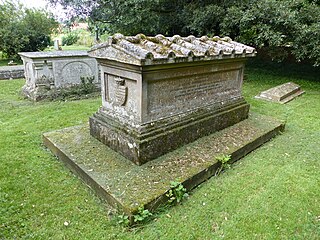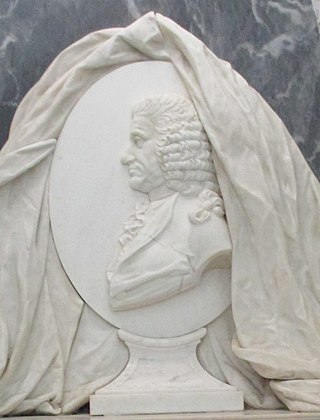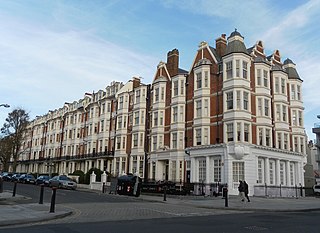Related Research Articles

Baron Willoughby de Eresby is a title in the Peerage of England. It was created in 1313 for Robert de Willoughby. Since 1983, the title has been held by Jane Heathcote-Drummond-Willoughby, 28th Baroness Willoughby de Eresby.
There have been two baronetcies created for persons with the surname Wynn, with the Gwydir family in the Baronetage of England and the Bodvean family in the Baronetage of Great Britain.
Gilbert James Heathcote-Drummond-Willoughby, 3rd Earl of Ancaster, styled Lord Willoughby de Eresby from 1910 to 1951, was a British Conservative politician.
Clementina Elizabeth Drummond-Willoughby, 24th Baroness Willoughby de Eresby was a suo jure British baroness. She was the daughter of Peter Robert Drummond-Burrell, 22nd Baron Willoughby de Eresby and Sarah Clementina, née Drummond. On the death of her brother, Albyric Drummond-Willoughby, 23rd Baron Willoughby de Eresby, in 1871, the Barony of Willoughby de Eresby fell into abeyance between her sister, Charlotte, and her. On 13 November 1871, the abeyance of the barony was terminated in her favour.

Robert John Carrington, 2nd Baron Carrington,, was a politician and a baron in the Peerage of Great Britain. He was the son of Robert Smith, 1st Baron Carrington, and Anne Boldero-Barnard. He adopted the name "Carrington" in 1839.

Priscilla Barbara Elizabeth Bertie, 21st Baroness Willoughby de Eresby, known before 1780 as Lady Priscilla Bertie, was a daughter of the Peregrine Bertie, 3rd Duke of Ancaster and Kesteven, and Mary Panton. Through her grandmother Mary Wynn, Priscilla Bertie was a descendant of the Welsh princely House of Aberffraw.

Albyric Drummond-Willoughby, 3rd Baron Gwydyr, 23rd Baron Willoughby de Eresby, was a British noble baron. He was the son of Peter Drummond-Burrell, 22nd Baron Willoughby de Eresby, and Sarah Clementina, née Drummond. He never married.

Peter Robert Drummond-Burrell, 2nd Baron Gwydyr, 22nd Baron Willoughby de Eresby PC, was a British politician and nobleman.
Peter Burrell, 1st Baron Gwydyr PC featured in English politics at the end of the 18th century, but he was best known for his involvement in cricket, particularly his part in the foundation of Marylebone Cricket Club in 1787.

Algernon Percy, 1st Earl of Beverley FSA, styled Lord Algernon Percy between 1766 and 1786 and known as the Lord Lovaine between 1786 and 1790, was a British politician who sat in the House of Commons from 1774 to 1786 when he succeeded to the Peerage.

There has been one baronetcy created for a person with the surname Burrell. Another baronetcy passed by special remainder to the Burrell family.
There have been two baronetcies created for people with the surname Heathcote, both in the Baronetage of Great Britain and both created in 1733. The holders of the first creation were later elevated to the peerage as Baron Aveland and Earl of Ancaster, which titles are now extinct. However, both baronetcies are extant as of 2008.

Gilbert John Heathcote, 1st Baron Aveland, known as Sir Gilbert John Heathcote, 5th Baronet from 1851 to 1856, of Stocken Hall, Rutland, was a British peer and Whig politician.

Sir Merrik Burrell, 1st Baronet was a British politician.
Peter Burrell may refer to:

Peter Robert Burrell, 4th Baron Gwydyr was High Sheriff of Suffolk in 1858. In addition, he was Secretary to the Lord Great Chamberlain, High Steward of Ipswich, and Chairman of Quarter Sessions, Suffolk. Burrell succeeded to the title of 4th Baron Gwydyr, of Gwydyr, County Carnarvon, on 26 August 1870.

Willoughby Merrik Campbell Burrell, 5th Baron Gwydyr, FRGS was a British Army officer and peer.
James Drummond, 1st Baron Perth, was a Scottish soldier, landowner and peer.

Gwydyr Mansions is a block of mansion flats in the centre of Hove, part of the English coastal city of Brighton and Hove. Built on the initiative of a Baptist pastor and designed by the prolific architecture firm of Clayton & Black, the "elegant" Flemish Renaissance-style building dates from 1890 and overlooks a central square. As originally built, the block had a restaurant and barber shop for residents; the latter is still operational.
The Raymond Baronetcy of Valentine House, in the County of Essex, was created in the Baronetage of Great Britain on 31 May 1774 for Charles Raymond, of Valentines, Ilford in Essex, who was High Sheriff of Essex from 1771 to 1772. It was created with remainder to his son-in-law William Burrell, who succeeded him as second Baronet. The latter was the nephew of the first Burrell baronet of the 1766 creation and the uncle of the first Baron Gwydyr. The third Burrell baronet succeeded to the title of Baronet Raymond of Valentine House on 20 January 1796.
References
This article needs additional citations for verification .(November 2021) |
- ↑ "No. 13897". The London Gazette . 31 May 1796. p. 527.
- ↑ "No. 10641". The London Gazette . 12 July 1766. p. 1.
- ↑ Middleton, Judy (2002). The Encyclopaedia of Hove & Portslade. Brighton: Brighton & Hove Libraries. Vol. 6, p. 68.
- Hesilrige, Arthur G. M. (1921). Debrett's Peerage and Titles of courtesy. 160A, Fleet street, London, UK: Dean & Son. p. 429.
{{cite book}}: CS1 maint: location (link)